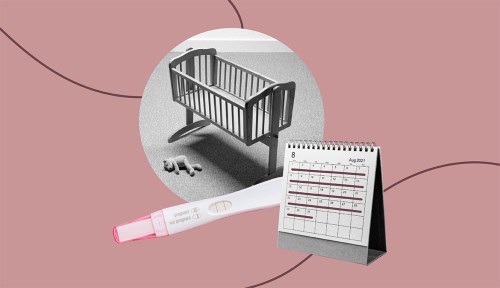Stranded alone. That’s how Simmone Taitt describes feeling in 2016 after her OB/GYN told her that “her body had terminated her pregnancy.” While she was quite literally alone in her body again, it wasn’t just the absence of a heartbeat on an ultrasound that she was forced to confront. She was also faced with the absence of clear medical directions for what to do or expect next (her doctor had dismissed her with a brusque, “I’ll see you in a few months when you start trying again”) and the cultural absence of a support system for this unique type of loss. As she scoured the internet for advice on the former, she also ran up against a harsh indication of the latter: The U.S. has no national paid parental-leave policy, much less one for pregnancy-loss leave.
Experts in This Article
perinatal psychiatrist, associate professor in the department of psychiatry and behavioral sciences at the Medical University of South Carolina (MUSC), and director of the Women’s Reproductive Behavioral Health Program at MUSC
doula, and CEO and co-founder of sexual and reproductive health education platform Loom
founder and CEO of Poppy Seed Health, a telehealth app for pregnant and postpartum people
In the moments just after learning of her loss, which occurred in an early-morning appointment during her first trimester, Taitt had to immediately determine whether she needed to go to work that day—a consideration that felt ludicrous as she stood tear-struck and heartbroken on the street outside her doctor’s office. At the time, she was a manager at a tech company that, like the country at large, didn’t offer any benefit in the realm of pregnancy-loss leave.
“I had to do this mental calculation of, ‘How many sick days do I have left to spare?’ and beyond that, ‘How many vacation days do I have?’ because maybe this isn’t just one sick day, like when you have a bad headache. So, perhaps it’s a few days. And then, it turned into, ‘Do I really want to be using my vacation days for this?’ Because this was surely not going to be a time of relaxation,” says Taitt.
Paired with the lack of care-related guidance she’d received from her doctor, this lack of resources from her place of work just reinforced Taitt’s sense of isolation. It was only upon finding an online message board for doulas—peppered with questions from other folks in her shoes—that she began to feel seen. While the exact numbers vary because, in some cases, birthing people are not aware that they’re pregnant when they experience a loss or may not report it, research has shown that as many as 20 percent of known pregnancies are lost to either miscarriage (before the 20th week) or stillbirth (at or after the 20th week). This equates to roughly 1 million people experiencing pregnancy loss in the U.S. every year (and recent studies point to rising rates of both miscarriages and stillbirths since the onset of the pandemic). Uncovering this high prevalence of pregnancy loss only made the low societal acknowledgement of it that much more unacceptable to Taitt—and lit an entrepreneurial fire within her.
In 2019, Taitt launched Poppy Seed Health, a text app that connects pregnant and postpartum people with on-demand access to doulas, midwives, and nurses, with membership starting at $29 a month. But, notably, anyone (even non-members) can text the company’s 24/7 hotline for free loss support and receive instant care from a trauma-informed expert. “We realized that there was just no way that we could be in the business of supporting birthing people, supporting postpartum people, supporting these peoples’ families without acknowledging that loss is a part of that journey,” she says.
Now, Taitt is advocating for the country to do the same by way of a law guaranteeing paid pregnancy-loss leave for all employees—that is, something similar in effect to the Support Through Loss Act, proposed this summer by Sen. Tammy Duckworth, which would guarantee three days of paid leave for anyone who’s experienced a pregnancy loss, failed adoption or surrogacy arrangement, or unsuccessful fertility procedure (as well as any partner of a person experiencing any of the above).
How pregnancy loss can create a debilitating mental and physical landslide
Although Taitt’s doctor sent her home in 2016 without any forewarning about what to expect, pregnancy loss is far from an isolated biological incident. For one, the person experiencing the loss will need to pass the pregnancy and shed their thickened uterine lining. “No matter what type of loss it is, there will be some blood loss after the fact,” doula, author, and CEO of Loom Erica Chidi previously told Well+Good. “That can continue for a few weeks, sometimes even up to six weeks.”
While that process is underway, levels of the pregnancy hormone HCG (human chorionic gonadotropin) and progesterone start to drop off—but as the brain works to catch up with the body, that dip also happens slowly, over the course of four to six weeks. As a result, mood swings, as well as typical pregnancy symptoms like headaches, nausea, and breast tenderness, can linger, too.
“While the loss of a loved one is the loss of who that person was, a pregnancy loss is the loss of who that person and family could have been.” —Constance Guille, MD
Coupled with these physical symptoms is a socio-emotional cascade, says perinatal psychiatrist Constance Guille, MD, founder and director of the Women’s Reproductive Behavioral Health Program at the Medical University of South Carolina. “While the loss of a loved one is the loss of who that person was, a pregnancy loss is the loss of who that person and family could have been,” she says. “All the hopes and dreams people have when conceptualizing a future family can feel lost with a miscarriage.”
And that emptiness may only be magnified by the related societal stigmas, says Taitt, who remembers feeling ashamed and like her body had failed her in the aftermath of her first miscarriage (which would be followed by two more). “People often feel as though they’re responsible for the loss, or that something is wrong with them,” says Dr. Guille. “When they don’t have time to process this and heal, the pain and suffering shows up in other ways, such as depression, anxiety, disconnection from others, difficulties in relationships, and substance use.”
Recent research backs up her assertion: A 2019 study analyzing more than 700 people who experienced early pregnancy loss found that 29 percent of them showed symptoms of post-traumatic stress disorder; 24 percent demonstrated moderate to severe anxiety; and 11 percent showed signs of moderate to severe depression at one month following the event. And while time can certainly help mitigate these symptoms, they can still persist for months at clinical levels: At nine months following the pregnancy loss, the numbers for this study group were still pronounced, at 18 percent, 17 percent, and 6 percent, respectively.
Why pregnancy loss, at any stage, merits national paid leave
As of now, the United States is not only lacking any policy for pregnancy-loss leave, but is also one of just six countries in the world without any form of national paid leave. That is, all paid family, bereavement, and sick leave policies are currently left up to the discretion of the states—nine of which, plus the District of Columbia, have some version in place—and beyond that, individual employers. As a result, many employees don’t even have access to a related paid-leave benefit they can fall back on in the event of pregnancy loss.
The United States is one of just six countries in the world without any form of national paid leave.
Certain companies have begun to explicitly include pregnancy loss within their existing benefit rosters; for example, fertility company Progyny now offers five days, Reddit offers eight and a half weeks, and The Pill Club offers up to 16 weeks. But, of course, that still relegates the benefit to the folks who are lucky enough to work for the few employers that are stepping up. Because the need for paid pregnancy-loss leave (and yes, paid parental, bereavement, and sick leave, more generally) is a national one, it should instead be handled with legislation at the national level.
In fact, we’d be far from the first country to enact such a federal policy. Earlier this year, both Australia and New Zealand passed laws requiring two days and three days of paid pregnancy-loss leave, respectively, and a handful of other countries provide even greater protections. To name a few: India requires six weeks, the Philippines requires 60 days, and South Korea requires anywhere from five to 90 days, depending on the circumstances of the loss.
Because of how people are distributed across the workforce, only a national law can effectively ensure that every employee has access to the benefit, no matter their race, gender, or ethnicity. “We know that Black, Indigenous, and people of color are the ones disproportionately employed in hourly and shift work at companies that are less likely to offer any type of paid leave,” says Taitt. “And they might not have the privilege of saying, ‘I can’t show up for work today,’ even though they just had a miscarriage. So, what happens when the government steps in is, at least there’s a guarantee.”
Once that safety net is firmly in place, employees no longer need to be concerned with job or salary security as they prioritize their mental and physical health following pregnancy loss. “It creates a safer, more trusting space, where people feel like they can discuss pregnancy or pregnancy loss without being a liability to their company,” says Taitt. And that, in turn, brings pregnancy loss into the light of day, where it belongs.
“The unspoken rule is that you shouldn’t tell anyone that you’re pregnant in the first trimester just in case. But that ‘just in case’ is exactly why it helps to share,” Taitt says. “It’s in the first trimester when you most need people to be there to support you, no matter what the outcome is.”
What an effective pregnancy-loss leave policy might look like
From Taitt’s perspective, adequate leave would include both paid time off for the birthing person and their partner, if they have one, and, critically, access to mental-health support. While Poppy Seed Health offers its own share of resources, both for employees and employers, Taitt also points to organizations like Return to Zero: Hope and The Institute for the Study of Birth, Breath, and Death for support and training purposes.
And though she hopes people who experience pregnancy loss feel increasingly empowered to seek care and community on their own, as she did, the true onus remains on both employers and the country at large to create an environment where pregnancy loss is recognized and supported.
“We are at a critical point where it’s no longer acceptable to ignore the fact that the whole human who comes to work every day, who contributes to a workplace’s productivity, who’s a part of your community may also be family planning, or pregnant, or struggling in ways that are invisible,” says Taitt. Having pregnancy-loss leave and mental-health resources available makes the invisible visible, and shows a person experiencing this unique type of loss that they’re not, in fact, alone.
Oh hi! You look like someone who loves free workouts, discounts for cutting-edge wellness brands, and exclusive Well+Good content. Sign up for Well+, our online community of wellness insiders, and unlock your rewards instantly.
Sign Up for Our Daily Newsletter
Get all the latest in wellness, trends, food, fitness, beauty, and more delivered right to your inbox.
Got it, you've been added to our email list.











